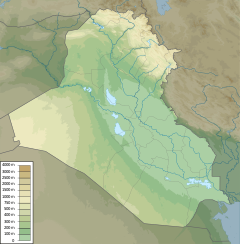Mosque-Madrasa of al-Asifyah
| Mosque-Madrasa of Al-Asifyah | |
|---|---|
 | |
| Religion | |
| Affiliation | Islam |
| Ecclesiastical or organisational status | Mosque and madrasa |
| Status | Active |
| Location | |
| Location | Tigris riverbank, Baghdad, Iraq |
Location in Iraq | |
| Geographic coordinates | 33°20′20″N 44°23′21″E / 33.3389°N 44.3892°E |
| Architecture | |
| Style | |
| Creator | Dawud Pasha |
| Date established | 1608 |
| Specifications | |
| Capacity | 500 worshipers |
| Interior area | 400 square metres (4,300 sq ft) |
| Dome(s) | 2 |
| Minaret(s) | 2 |
| Shrine(s) | 1 (dedicated to Al-Kulayni) |
The Mosque-Madrasa of al-Asifyah (Arabic: مدرسة الآصفية) is a complex of mosque and madrasa located near the riverbank of Tigris, in Baghdad, Iraq. The mosque and its associated complex including school buildings, old courts and other former government buildings, and a palace are contained within a 7.57-hectare (18.7-acre) site alongside the banks of the Tigris that forms part of a tentative UNESCO World Heritage Site.[1]
The mosque complex also includes a small shrine, which is believed to entomb the remains of al-Kulayni.[2]
Historical background[edit]
Background and founding[edit]
The way the tomb was built indicates that the shrine was originally supposed to be a tomb of one of the Abbasid Caliphs. As the area where the complex was built used to be a cemetery for Banu Abbas, as mentioned by some historians. It was uncommon for Abbasid caliphs to spend about ten thousand dinars on the building of a shrine similar to this one and people at that time never decorated graves sites in respect to the traditions of Muhammad, so it is possible that this was originally an Abbasid tomb. The mosque was one of the facilities and accessories of the madrasa, so it is possible that the builder of the aforementioned madrasa would be buried in it.[3]

The complex originally consisted of a mosque, tekyeh and khan, and was called Mawla Khana Tekeyyiah. Later the building that belonged to the original complex was eroded and had to be demolished. The complex was then taken over by one of the students of the tekyeh who belonged to the Sufi tariqa, until the building was renovated by Muhammad Jalabi Khatib Al-Diwani in 1596. It then became the facility of Mustansiriya Madrasah. The building was renovated again by the ruler Mamluk of Baghdad Dawud Pasha in 1825.[1] During the time, two madrasas were built for elementary and secondary levels, attached with preaching area and a minaret. He also reformed the mosque with larger prayer space, and erected two minarets to the south of the mosque made of stone and decorated with Qashani tiles. The buildings were engraved with the poetry by Sheikh Saleh al-Tamimi.[4]
Later events[edit]
Among the sheikhs who taught in the complex was Sheikh Ali bin Hussein al-Kuti, who died in 1917, and the last teacher in the madrasa was Sheikh Abd el-Jalil bin Ahmed al-Jamil, who died in 1957. Teaching in the madrasa was canceled after his passing, and the archaeological library of the complex was transferred to the Public Endowments Library located in Bab al-Muazzam in Baghdad.[5]
Burials[edit]
• Muhammad ibn Ya'qub Ishaq Al-Kulayni, a notable Shi'ite Muslim scholar.
Gallery[edit]
-
A depiction by a foreign traveler of the Tigris River as well as the al-Kat’a Bridge and the Madrasa from an American Magazine, 1834.
-
Al-Asifyah Mosque next to Al-Wazeer Mosque on al-Shuhada Bridge, 2017.
See also[edit]
References[edit]
- ^ a b "Historical Features of the Tigris River in Baghdad Rusafa, which extends from the school Al-Mustansiriya to the Abbasid Palace". Tentative Lists: World Heritage Site. UNESCO. Retrieved January 3, 2018.
- ^ "Lessons from the Lives of our Ulema – Part 9". www.islamic-laws.com. Retrieved 2022-05-22.
- ^ "تحميل كتاب تاريخ مساجد بغداد وآثارها ل محمود شكري الألوسي pdf". كتاب بديا (in Arabic). Retrieved 2023-08-29.
- ^ Al-Darubi, Abdul Gani (1958). البغداديون أخبارهم ومجالسهم - مطبعة الرابطة (in Arabic). Baghdad. p. 275.
{{cite book}}: CS1 maint: location missing publisher (link) - ^ "تحميل كتاب البغداديون أخبارهم ومجالسهم ل إبراهيم الدروبي pdf". كتاب بديا (in Arabic). Retrieved 2023-08-29.



